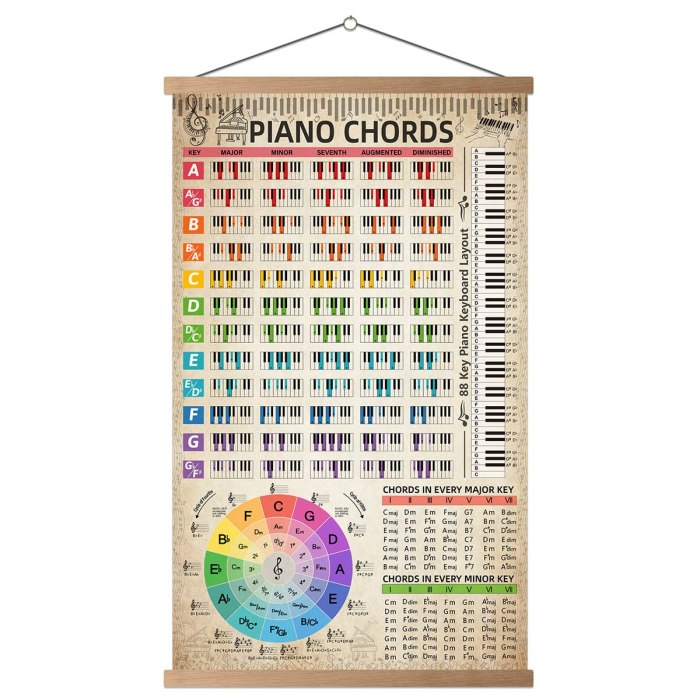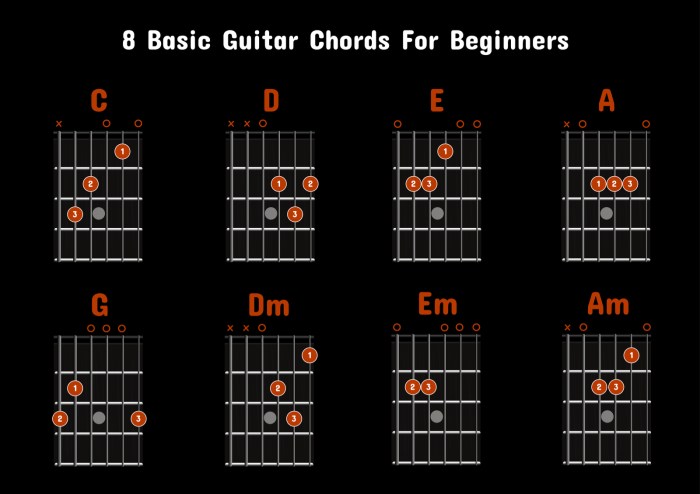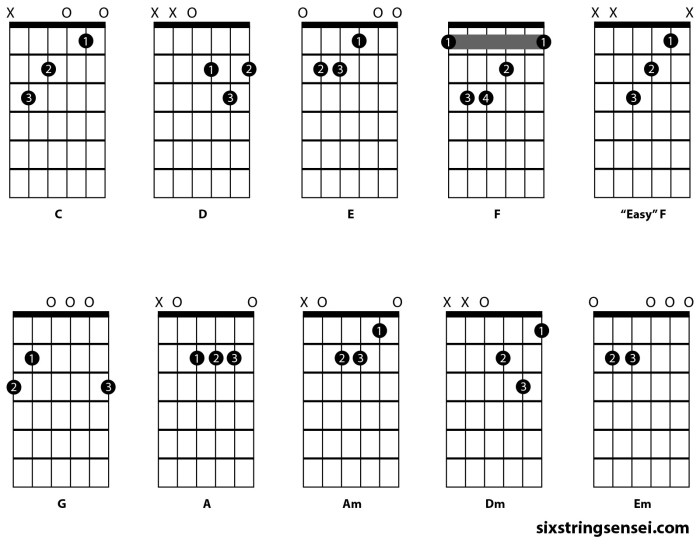Embark on a musical journey with How to Play Guitar: 15 Beginner Chords and Songs, where you’ll discover the foundations of guitar playing through essential chords and popular songs. Dive into the world of strumming patterns, chord transitions, and effective practice techniques in this engaging guide.
Learn how to position your fingers, refine your strumming skills, and elevate your playing with these beginner-friendly chords and songs.
Beginner Chords

Learning the essential beginner chords is the first step to playing the guitar. These chords form the foundation for countless songs and are crucial for beginners to master.
Identifying the 15 Essential Beginner Chords
- The C major chord: Place your ring finger on the 3rd fret of the 5th string, middle finger on the 2nd fret of the 4th string, and index finger on the 1st fret of the 2nd string.
- The G major chord: Place your ring finger on the 3rd fret of the 1st string, middle finger on the 2nd fret of the 5th string, and index finger on the 2nd fret of the 6th string.
- The D major chord: Place your index finger on the 2nd fret of the 3rd string, ring finger on the 3rd fret of the 2nd string, and middle finger on the 2nd fret of the 1st string.
- The A major chord: Place your index finger on the 2nd fret of the 4th string, middle finger on the 2nd fret of the 3rd string, and ring finger on the 2nd fret of the 2nd string.
- The E major chord: Place your index finger on the 1st fret of the 3rd string, middle finger on the 2nd fret of the 5th string, and ring finger on the 2nd fret of the 4th string.
- The A minor chord: Place your index finger on the 1st fret of the 2nd string.
- The E minor chord: Place your index finger on the 2nd fret of the 5th string.
- The D minor chord: Place your index finger on the 1st fret of the 1st string and middle finger on the 2nd fret of the 3rd string.
- The C major 7 chord: Place your index finger on the 2nd fret of the 4th string and middle finger on the 2nd fret of the 2nd string.
- The G major 7 chord: Place your index finger on the 1st fret of the 1st string, middle finger on the 2nd fret of the 5th string, and ring finger on the 2nd fret of the 6th string.
- The D major 7 chord: Place your index finger on the 2nd fret of the 3rd string, ring finger on the 3rd fret of the 2nd string, and pinky finger on the 2nd fret of the 1st string.
- The A major 7 chord: Place your index finger on the 1st fret of the 4th string, middle finger on the 1st fret of the 3rd string, and ring finger on the 2nd fret of the 2nd string.
- The E major 7 chord: Place your index finger on the 1st fret of the 3rd string, middle finger on the 2nd fret of the 5th string, and ring finger on the 2nd fret of the 4th string.
- The A7 chord: Place your index finger on the 1st fret of the 4th string.
- The D7 chord: Place your index finger on the 1st fret of the 2nd string and middle finger on the 2nd fret of the 3rd string.
Comparing the Difficulty Level of Each Chord
- The C major, G major, D major, A major, and E major chords are relatively easy for beginners to learn as they involve basic finger placements.
- Chords like A minor, E minor, and D minor introduce variations but are still manageable for beginners with practice.
- Chords such as C major 7, G major 7, D major 7, A major 7, and E major 7 add complexity with additional finger placements but are achievable with practice and patience.
- The A7 and D7 chords are relatively simple to play and are good for beginners to start incorporating into their practice routine.
Playing Techniques

When learning how to play guitar, mastering basic playing techniques is essential to progress and improve your skills. This includes understanding strumming patterns, transitioning between chords smoothly, and maintaining proper hand positioning and posture.
Basic Strumming Patterns
- Start with a simple down-up strumming pattern: Practice strumming down with the pick followed by strumming up, keeping a steady rhythm.
- Experiment with different strumming patterns: Try variations like down-down-up or down-up-down to add dynamics to your playing.
- Focus on consistent timing: Strum in time with the music and use a metronome to practice keeping a steady beat.
Transitioning Between Chords
- Visualize chord shapes: Before transitioning, visualize the next chord shape in your mind to prepare your fingers for the movement.
- Practice chord changes slowly: Start by transitioning between two chords at a slow pace, focusing on accuracy rather than speed.
- Use common fingers as anchors: When moving between chords, keep fingers that are shared between the chords in place as anchor points for smoother transitions.
Hand Positioning and Posture
- Keep your wrist straight: Avoid bending your wrist too much when fretting chords to prevent strain and allow for better finger mobility.
- Position your thumb behind the neck: Place your thumb behind the guitar neck to provide support and stability while fretting chords.
- Sit or stand with good posture: Maintain a relaxed yet upright posture while playing, as slouching can affect your playing technique and overall comfort.
Beginner Songs

Playing popular songs using the 15 beginner chords is a great way to practice and improve your chord transition skills. By mastering these songs, you will not only enhance your ability to switch between chords smoothly but also gain confidence in your guitar playing. Here are some tips on how to effectively practice and master playing these songs:
List of Popular Songs
- “Wonderwall” by Oasis
- “Horse with No Name” by America
- “Knocking on Heaven’s Door” by Bob Dylan
- “Good Riddance (Time of Your Life)” by Green Day
- “I’m Yours” by Jason Mraz
Improving Chord Transition Skills
Learning to play these songs will require you to switch between the beginner chords quickly and accurately. This constant movement between chords will help train your fingers to move smoothly on the fretboard, improving your muscle memory and coordination. The more you practice these songs, the easier it will become to transition between chords effortlessly.
Tips for Effective Practice
- Start slow: Begin by practicing the chord transitions at a slower tempo to ensure accuracy and proper finger placement.
- Use a metronome: Practicing with a metronome can help you maintain a steady rhythm and gradually increase your speed over time.
- Focus on difficult transitions: Identify the chord changes that are challenging for you and dedicate extra practice time to those transitions.
- Practice regularly: Consistent practice is key to mastering these songs, so make sure to set aside time each day to work on your chord transitions.
Closing Notes

Unleash your musical potential and enhance your guitar skills by mastering the 15 beginner chords and songs covered in this comprehensive guide. Whether you’re a novice or looking to brush up on the basics, this resource equips you with the tools to start playing your favorite tunes with confidence and flair.